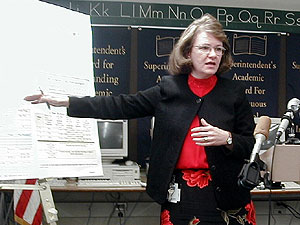|
Photos
More from MPR
Resources
Your Voice
|
New state report cards will grade every school
July 24, 2003
 |
| Education Commissioner Cheri Pierson Yecke explains the format of new state report cards. (MPR Photo/Tim Pugmire) |
St. Paul, Minn. — The accountability provisions of the No Child Left Behind law require states to produce and distribute annual report cards for schools receiving federal funds for disadvantaged students. Minnesota officials are producing a condensed, easy-to-read version for all schools. The basic format is ready, but individual school reports won't be available until late August. Gov. Tim Pawlenty says the public is getting a powerful tool.
"This is something that we believe every Minnesota family should have on their kitchen table," Pawlenty said. "It's going to enable parents and taxpayers and educators and interested citizens to be able to, in a snap shot, see key performance measurements for every school site in the state of Minnesota."
The Minnesota Department of Education will use those measurements for the first time to grade every school. A rating of one or two stars is earned if any student group in a school fails to meet reading and math goals. State officials recently identified 259 schools not making the adequate yearly progress required under federal law. The remaining 1,600 schools will fall in the three to five star range.
|
This is something that we believe every Minnesota family should have on their kitchen table.
- Gov. Tim Pawlenty |
Education Commissioner Cheri Pierson Yecke says schools that earn up to five stars are meeting performance goals, have few students scoring below grade level and rank high among comparable schools.
"We felt that it was much more important in Minnesota to show a broader number of indicators, and a wider breadth of what was going on in the schools other than just adequate yearly progress," Yecke said.
The report cards include test scores broken down by race, English proficiency, disability, family income and other factors. They track annual performance gains or losses. Incidents involving weapons, drugs or other disciplinary issues in the school are detailed.
Teachers' professional qualifications, such as the percentage of staff teaching core academic classes without certification in those subjects, are outlined. Financial data shows where school districts get their money and how it's spent.
Yecke says the online version of the reporting system will soon allow parents to quickly compare financial numbers among school districts.
"If my district spends 70 percent of their funds on classroom instruction, and the one down the street spends 60 percent on classroom instruction, those are the sorts of bits of data that we'll be able to know once we get this up and running," Yecke said.
Individual school performance reports are old hat in St. Paul. Superintendent Pat Harvey launched a similar accountability effort two years ago. Those reports include test scores, student demographics and financial data, but the schools are not graded. Harvey says she agrees with the state's information goals. She's just not yet sure about the school grades.
"It will be very difficult for some of our schools which have the largest percentage poverty students to be able to be five star," Harvey said. "But we will continue to work toward that goal."
The head of the state's teachers union says the rating system is overly simplistic for complex schools. Judy Schaubach, president of Education Minnesota, says such labeling could be counter-productive.
"It is very difficult to try to quantify that in a single star or a five-star kind of ranking," Schaubach said. "And I think in some cases that may give an unfair label to a school. And I just would encourage people to look beyond this. It certainly can provide some information, but it doesn't tell the whole story." The Department of Education plans to begin distributing individual school report cards at the Minnesota State Fair. The information will also be made available on the agency's Web site.
|
News Headlines
|
Related Subjects
|
